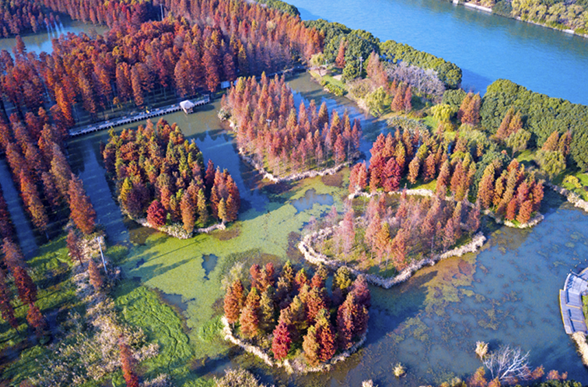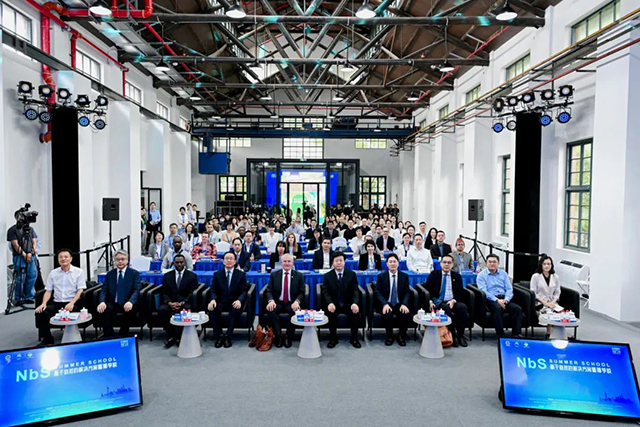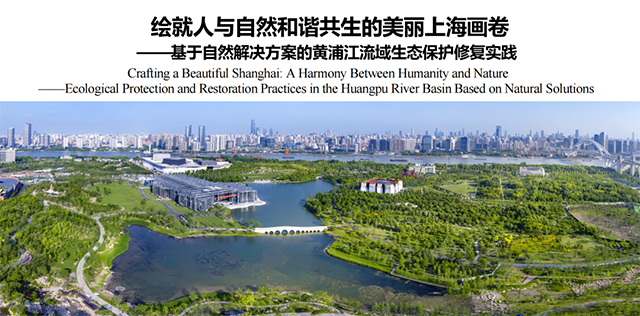


As the world faces multiple challenges such as climate change and biodiversity loss, Nature-based Solutions (NbS) have become a globally recognized approach for environmental protection and sustainable development.
On June 23, 2025, coinciding with China’s 35th National Land Day, the inaugural global Summer School on Nature-based Solutions was grandly launched on Fuxing Island in Shanghai. The event attracted around 150 participants, including representatives from the International Union for Conservation of Nature (IUCN), the Global Center for NbS, China's Ministry of Natural Resources, the National Forestry and Grassland Administration, the National Oceanic Administration, the Shanghai Bureau of Natural Resources Supervision, the Shanghai Municipal Bureau of Planning and Natural Resources, Yangpu District, renowned global experts, trainees, and media representatives.
During the opening ceremony, speeches were delivered by Mr. Sun Shuxian, Vice Minister of Natural Resources and Administrator of the National Oceanic Administration; Mr. Stewart Maginnis, Deputy Director General of IUCN; Mr. Li Yunqing, Deputy Administrator of the National Forestry and Grassland Administration; representatives from the People’s Government of Yangpu District, and international participants.

Figure 1: Nature-based Solutions Summer School
With strong support from the Department of International Cooperation and the Department of Ecological Restoration of the Ministry of Natural Resources, as well as the China Land Consolidation and Rehabilitation Center, two significant global firsts were unveiled at the event: the official establishment of the world’s first Urban NbS Center in Shanghai, and the global launch of the “Shanghai Case.” These mark a solid step forward in advancing global ecological governance and building new platforms for international cooperation on NbS.

Figure 2: Opening Ceremony
World’s First Urban NbS Center Established in Shanghai
The Shanghai Urban NbS Center is dedicated to promoting research, local practice, and international cooperation around NbS. It aims to share Shanghai’s experience in building an “ecological city” as a mega estuarine and marine metropolis, to promote China’s approach to ecological civilization, and to co-create a sustainable development model that fosters harmony between humans and nature in high-density urban settings-supporting ecological conservation and green development in Asia and beyond.
The NbS approach, along with its associated technologies and methods, provides critical support for creating near-natural blue-green infrastructure and high-quality ecological spaces in megacities. Fuxing Island, the location of the new center, exemplifies this integration. Aligned with its vision of becoming a "Smart Island," "Design Island," and "People’s City Island," the area leverages NbS to highlight its spatial characteristics, blending ecological restoration with urban development. Through restoring natural genes, softening ecological shorelines, and enabling multifunctional integration, it creates an ecologically rich space that supports biodiversity and offers residents an immersive waterside experience. Fuxing Island also plays a key role in the Shanghai Case.

Figure 3: Inauguration of the NbS Shanghai Center
Launch of the “Shanghai Case”
During the event, the global debut of the “Shanghai Case” was held. Mr. Zhang Yuxin, Director General of the Shanghai Municipal Bureau of Planning and Natural Resources, released the report titled “Nature-based Ecological Protection and Restoration Practices in the Huangpu River Basin.” In alignment with the goals set by the municipal government and guided by Xi Jinping’s thought on ecological civilization, Shanghai has embraced the “People’s City” concept, integrating ecological advancement into the modernization journey with Chinese characteristics. Following the ecological vision laid out in the Shanghai 2035 Master Plan and its spatial pattern of “Two Belts, Nine Corridors, and Ten Zones,” NbS has become a key strategy for building the ecological city and network. The report highlights key examples of NbS planning and implementation in Shanghai, including the "Haipai Jiangnan" initiative, the Expo Cultural Park, the Fuxing Island Ecological Symbiosis Space, and the Resilient Coastal Belt. It showcases Shanghai’s nuanced understanding of ecological development in megacities and its international, strategic outlook. Shanghai’s innovative approach is founded on holistic planning, citywide coordination, and tailored strategies. The city has developed a blue-green base characterized by wetlands, rivers, forests, farmland, lakes, and bays, and introduced a watershed-level governance model that promotes upstream ecological conservation, midstream urban-ecological integration, and downstream land-sea resilience.

Figure 4: Launch of the NbS Shanghai Case
Upstream suburban areas: Drawing from the cultural and ecological roots of “Haipai Jiangnan,” Shanghai has implemented actions such as heritage protection, suburban park construction, and water-town wetland creation. These efforts enhance ecological stability and biodiversity while preserving the poetic ambiance of Jiangnan water towns.

Figure 5: Suburban Area - Qingxi Countryside Park
Midstream urban areas: Embracing the “re-naturalization of space,” the city has reconnected a 45 km stretch of the Huangpu River waterfront through the construction of ecological buffer zones and landmark projects like the Expo Cultural Park and the Fuxing Island symbiosis zone. Meanwhile, small-scale urban ecological gardens have been created within residential areas, schools, streets, and commercial zones, forming a network of ecological “stepping stones” to bring green benefits directly to residents’ doorsteps.

Figure 6: Urban Area - Expo Cultural Park
Downstream coastal areas: By designing a “resilient eco-dike” and planning the V-shaped coastal belt, Shanghai has systematically restored key wetland nodes along its estuarine coastline, strengthening the ecological functions of the land-sea interface and building a blue-green living community.

Figure 7: Coastal Area - Dongtan National Wetland Park
The establishment of the Shanghai Urban NbS Center and the launch of the “Shanghai Case” add a significant chapter to Shanghai’s journey as an “ecological city” and provide a robust platform for advancing NbS as a leading solution for global ecological governance. IUCN Deputy Director General Stewart Maginnis praised Shanghai for introducing an integrated ecological restoration approach to the Huangpu River Basin, stating that the city has emerged as a global leader in comprehensive ecological governance.
Looking ahead, Shanghai will continue to uphold the vision of a “People’s City,” and, under the guidance of the Ministry of Natural Resources and the municipal leadership-with continued support from IUCN-strive to harmonize high-quality development with high-level ecological protection. Leveraging the platform of the world’s first Urban NbS Center, Shanghai will deepen localized NbS practices, uphold Eastern ecological wisdom, strengthen megacity ecological self-discipline, and contribute Chinese insights and the “Shanghai Solution” to the sustainable development of global megacities.
Source: <https://mp.weixin.qq.com/s/39zeydZ1uXPmBwZAMKDC8Q>
Editor & Translator:Li Chun